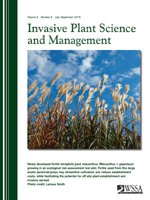Curtis Prairie is an 80-yr-old restored prairie that, despite its diverse vegetation and dense cover, was invaded by Phalaris arundinacea (reed canarygrass) during the 1980s. Our search for a method to eradicate Phalaris involved field tests of a grass-specific herbicide (sethoxydim as Vantage®). To reduce Phalaris growth and favor native vegetation, we used an adaptive approach that began in 2005 by testing sethoxydim application with and without adding a seed mix of 32 native plants. Sethoxydim reduced flowering but not cover of Phalaris; we therefore reapplied sethoxydim to all the 2005 plots in 2006 and again in 2007. We began a second experiment in 2006 that combined late-May burning followed by late-June sethoxydim application. This combination reduced Phalaris cover the most of all treatments. In a third experiment in 2007 we repeated the late-May burn late-June sethoxydim treatment but did not find a reduction in Phalaris cover. We attribute differences in burning herbicide effects to year effects. Because the Phalaris canopy remained dense even where we applied sethoxydim for 3 yr (first experiment, 2005), we were not surprised that our 2005 seeding of 32 native forbs and graminoids (but not grasses) barely increased native species presence. Six years after seeding, however, we found 12 of the seeded species along with 21 unseeded natives. The adaptive approach of designing new experiments based on prior results led to a promising approach in 2006 (burning before applying sethoxydim to the resprouting Phalaris). Repeating that combination in 2007 indicated a year effect and that no single approach would eradicate this clonal grass.
Nomenclature: Sethoxydim; reed canarygrass, Phalaris arundinacea L.
Management Implications: Adaptive management requires information exchange among researchers and managers to develop science-based decisions. Our example in Curtis Prairie shows there is no simple approach that will control reed canarygrass (Phalaris arundinacea) and restore native vegetation. Instead, we found variable outcomes over time for sequential field experiments. First, we removed the litter and standing dead biomass accumulated from the previous year with a site-preparation burn in early April 2005. Our subsequent test of the timing of a grass-specific herbicide showed that sethoxydim (as Vantage) temporarily halted flowering of Phalaris (thereby keeping the canopy short). We found the same response in two subsequent years (one herbicide application per year). At no time was there evidence that this herbicide could kill the invader. Sethoxydim was not effective despite being labeled a grass-specific herbicide.
In 2006, a new field experiment compared the sethoxydim treatment with and without a growing-season burn treatment in late May, expecting the burn to reduce the live canopy cover and potentially stimulate seed germination of native species. A late-May burn followed by sethoxydim in late June was effective in reducing cover in 2006; however, when we repeated the treatment in 2007 (our third experiment), there was little effect. The level of control achieved in this year deserves further research to find optimal conditions when the invader will respond to a burn followed by an herbicide.
Sowing seeds of 32 native perennial plants (excluding grasses) did not establish natives in 2005, but some species appeared by 2007. Carex stipata and Asclepias incarnata were found to be expanding in 2011 to 2012. Long-term follow-up is needed to document lag effects.
Adaptive restoration improved our understanding of limitations of both invader eradication and native plant restoration. Repeating the most promising treatment demonstrated the importance of conducting multiple tests before recommending





